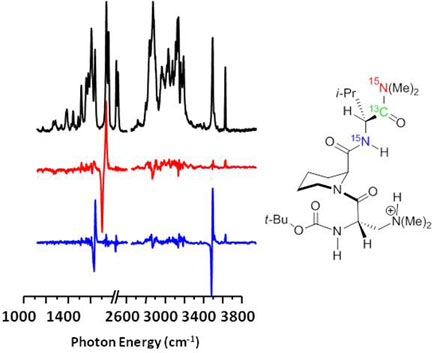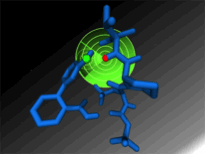Mark Johnson
Member of Yale faculty since 1985
Research Interest
Research
We are excited by the prospect of expanding the role of contemporary physical chemistry to address the mechanisms of complex synthetic pathways at the molecular level. To accomplish this, we blend together multi-dimensional laser spectroscopies, reaction dynamics, and cryogenic ion chemistry to create a central role for P-chem in the wider chemical community. Most recently, this endeavor involves integration of bioanalytical methodology to access transient species in solution, an advance that dramatically expands the scope of chemistry we can address. Areas that most interest us at present are:
- Structural characterization of host-guest linkages at the heart of supramolecular chemistry
- Capture and photochemical conversion of key intermediates in catalytic transformation of CO2 and H2O into solar fuels
- Clarification of the micro-hydration regime where every water molecule plays a specific role in charge translocation and covalent bond formation
- Development of new analytical tools for small molecule drug discovery
Many of these projects involve close collaborations with inorganic and organic synthesis as well as chemical biology groups. Our custom instruments specifically designed to meet these challenges are evolving rapidly as dictated by the requirements of the chemical processes we seek to understand.
We embarked on this adventure over twenty years ago with the goal of understanding chemical processes that occur in condensed phases by extracting key species directly from solution, freezing them into well defined geometries and characterizing the potential energy surfaces that govern reactions through precision spectroscopic measurements. In many cases, this course required us to design and construct new types of sophisticated instrumentation that draw inspiration equally from analytical chemistry and atomic physics. Most recently, we have commissioned a powerful new class of spectrometers that effectively brings an FTIR-like capability to mass spectrometry. With it, we can structurally analyze the wide range of species accessible through atmospheric ionization techniques like electrospray ionization. In essence, we combine multi-dimensional laser spectroscopy with the extreme sensitivity of mass spectrometry to yield a qualitative new and powerful way to study chemical processes. Because our capabilities are new, students in this program often get the first look at chemical phenomena, and thus access the most exciting aspects of science where qualitative understanding is achieved through application of precision measurements, basic theory, simulation, and synthesis. In our approach, these components are combined to challenge emerging hypotheses through experimental measurements on molecular scaffolds specifically designed to manipulate key features thought to control macroscopic chemical behavior. This program is well suited for those seeking an integrated and flexible approach to chemistry, and are comfortable with attacking new problems rather refining our understanding of old ones.

Upper trace: 10K vibrational spectrum of isolated tripeptide catalyst; Lower traces: difference spectra revealing positions of localoscillators by site-selective isotopic substitution.
Education
B.S. University of California, Berkeley, 1977
Ph.D. Stanford University, 1983
Postdoctoral Associate at J.I.L.A., University of Colorado, Boulder, 1983-85
Honors
NSF Presidential Young Investigator, 1987
Camille and Henry Dreyfus: Distinguished New Faculty, 1985;, Teacher-Scholar, 1990
Professeur Invité, Université de Paris-Sud 1988 & 1994; -Nord, 1998
Invited Lecturer by The Chemical Society of Brazil, 1997
Fellow of the American Physical Society, 1999
Japan Soc. for the Promotion of Science (J.S.P.S.) Fellow, 2001
NSF Award for Special Creativity, 2004
Fellow of the American Association for the Advancement of Science, 2005
APS Earle K. Plyler Prize for Molecular Spectroscopy, 2006
Yale College Dylan Hixon ’88 Prize for Teaching Excellence in the Natural Sciences, 2007
Chair, APS Division of Laser Science, 2008
Fellow of the American Academy of Arts and Sciences, 2009
Fellow of the American Chemical Society, 2010
Chair, ACS Division of Physical Chemistry, 2011
Co-Editor, Annual Review of Physical Chemistry, 2011-present
Alexander von Humboldt Senior Research Award, 2012
ACS Irving Langmuir Award in Chemical Physics, 2014
Elected member, National Academy of Sciences, 2014
Visiting Miller Research Professor, U.C. Berkeley, 2017
Selected Publications
F. S. Menges, S. M. Craig, N. Tötsch, A. Bloomfield, S. Ghosh, H.-J. Krüger, & M. A. Johnson. Capture of CO2 by a Cationic NiI Complex in the Gas Phase and Characterization of the Bound Activated CO2 Molecule through Cryogenic Ion Vibrational Predissociation Spectroscopy. J. Angew. Chem. Int. Ed. 2016, 55,1282.
C. T. Wolke, J. A. Fournier, L. C. Dzugan, M. R. Fagiani, T. T. Odbadrakh, H. Knorke, K. D. Jordan, A. B. McCoy, K. R. Asmis, & M. A. Johnson. Spectroscopic Snapshots of the Proton-transfer Mechanism in Water. Science 2016, 354, 1131-1135.
A. B. Wolk, C. M. Leavitt, E. Garand, & M. A. Johnson. Cryogenic Ion Chemistry and Spectroscopy. Acc. Chem. Res. 2014, 47, 202-210.
J. A. Fournier, C. J. Johnson, C. T. Wolke, G. H. Weddle, A. B. Wolk, & M. A. Johnson. Vibrational Spectral Signature of the Proton Defect in the Three-dimensional H+(H2O)21 Cluster. Science 2014, 344, 1009-1012.
E. Garand, M. Z. Kamrath, P. A. Jordan, A. B. Wolk, C. M. Leavitt, A. B. McCoy, S. J. Miller, & M. A. Johnson. Determination of Noncovalent Docking by Infrared Spectroscopy of Cold Gas-phase Complexes. Science 2012, 355, 694-698.
J. R. Roscioli, L. R. McCunn, & M. A. Johnson. Quantum Structure of the Intermolecular Proton Bond. Science 2007, 316, 249-254.
J. M. Headrick, E. G. Diken, R. S. Walters, N. I. Hammer, R. A. Christie, J. Cui, E. M. Myshakin, M. A. Duncan, M. A. Johnson, & K. D. Jordan. Spectral Signatures of Hydrated Proton Vibrations in Water Clusters. Science 2005, 308, 1765-1769.
N. I. Hammer, J. W. Shin, J. M. Headrick, E. G. Diken, J. R. Roscioli, G. H. Weddle, & M. A. Johnson. How do Small Water Clusters Bind an Excess Electron? Science 2004, 306, 675-679.
J. W. Shin, N. I. Hammer, E. G. Diken, M. A. Johnson, R. S. Walters, T. D. Jaeger, M. A. Duncan, R. A. Christie, & K. D. Jordan. Infrared signature of structures associated with the H+(H2O)n (n = 6 to 27) Clusters. Science 2004, 304, 1137-1140.
W. H. Robertson, E. G. Diken, & M. A. Johnson. Snapshots of Water at Work.Science 2003, 301, 320-321.
W. H. Robertson, E. G. Diken, E. A. Price, J. W. Shin, & M. A. Johnson. Spectroscopic Determination of the OH- Solvation Shell in the OH-• (H2O)n Clusters. Science 2003, 299, 1367-1372.
W. H. Robertson & M. A. Johnson. Caught in the Act of Dissolution. Science 2002, 298, 69.
J. M. Weber, J. A. Kelley, S. B. Nielsen, P. Ayotte, & M .A. Johnson. Isolating the Spectroscopic Signature of a Hydration Shell using Clusters: Superoxide Tetrahydrate. Science 2000, 287, 2461.
